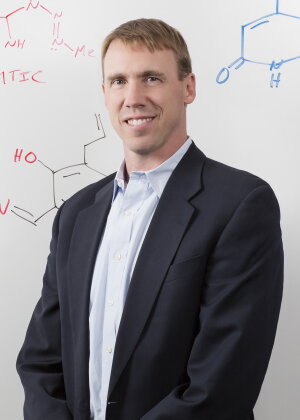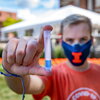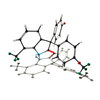
Contact Information
University of Illinois
261 RAL, Box 36-5
600 South Mathews Avenue
Urbana, IL 61801
Biography
Professor Hergenrother received his B.S. in chemistry from the University of Notre Dame in 1994. He went on to the University of Texas at Austin and obtained his Ph.D. in 1999; during this time Paul was the recipient of an American Chemical Society graduate student fellowship and the Roche Award for Excellence in Organic Chemistry. After an American Cancer Society post-doctoral fellowship at Harvard University, he joined the faculty at Illinois in 2001. His research interests are in the areas of synthetic organic chemistry, chemical biology, and biochemistry.
Research Interests
Design, synthesis, and evaluation of organic molecules with novel biological properties including enzyme inhibitors and activators; novel anticancer and antibacterial compounds; chemical biology and synthetic organic chemistry
Research Description
The overarching goal of our research is to use organic compounds to identify novel cellular targets that can be exploited in the treatment of diseases including cancer and drug-resistant bacteria. The compounds we discover are identified through a variety of approaches, including natural product synthesis, synthesis of complex-and-diverse compounds, structure-based design, and high-throughput screening. In the process, novel methods for the synthesis of various chemical building blocks and for biological assays often need to be developed. In addition, we work closely with the local medical community and perform tests directly on patient samples.
Synthesis of Complex and Diverse Compounds from Natural Products.
High-throughput screening remains the backbone of most drug discovery efforts, yet compounds in screening collections are typically simple molecules and are in screening collections because they were easy to synthesize. We have developed a new strategy for the rapid construction of complex and diverse compounds: Starting from abundant natural products, in five or fewer chemical steps these complex molecules are diversified to compounds that retain the complexity of natural products but that are very different from the parent structures. We have generated thousands of novel compounds through this "Complexity-to-Diversity" (CtD) method, compounds that now serve as starting points for future biological discoveries.
Novel anti-cancer targets.
A "personalized" cancer drug is one that exploits a molecular defect specifically present in the cancer cells of a patient. Our objective is to identify both novel biological targets for personalized medicine, and also novel compounds. One of our leading success stories in this area is the discovery that direct activation of procaspase-3 is a powerful and selective anticancer strategy, and the discovery of the first procaspase-activating compound, PAC-1. The anticancer activities of PAC-1 have now been well-documented and this compound is rapidly progressing toward human clinical trials. Another success story has been the identification of the natural product deoxynyboquinone (DNQ) as a powerful and personalized anticancer agent, in this case specific for those cancers that overexpress the enzyme NQO1. We are actively involved in the identification of many other personalized compounds and targets for the treatment of cancer.
Novel targets for drug-resistant bacteria.
Every year 90,000 people in the U.S. alone die from bacterial infections they acquire at hospitals, caused by pathogens that are resistant to multiple antibiotics. Gram-negative bacteria are the most urgent threat, as they are naturally resistant to many antibiotics and a novel drug class for treatment of Gram-negative infections has not been approved in 50 years. We are actively involved in several strategies to identify compounds that specifically kill drug-resistant bacteria. As one example, we have developed predictive guidelines for compound accumulation in Gram-negative pathogens, and we have used these guidelines to convert a Gram-positive-only antibiotic into a broad-spectrum agent.
Awards and Honors
ACS Sosnovsky Award for Cancer Research, 2018
Arthur C. Cope Scholar Award, 2017
ACS Akron Section Award, 2016
UCB-Ehrlich Award for Excellence in Medicinal Chemistry, 2016
Innovation Transfer Award, University of Illinois and Champaign County – 2016
University Scholar, 2014-2017
American Cancer Society Research Scholar, 2006-2010
Eli Lilly Award in Biological Chemistry, 2008
Camille Dreyfus Teacher-Scholar
Additional Campus Affiliations
Kenneth Rinehart Jr. Endowed Chair, Chemistry
Professor, Chemistry
Deputy Director, Cancer Center at Illinois, Office of the Vice Chancellor for Research and Innovation
Professor, Carl R. Woese Institute for Genomic Biology
Professor, Biomedical and Translational Sciences
External Links
Highlighted Publications
Boudreau, M. W., Duraki, D., Wang, L., Mao, C., Kim, J. E., Henn, M. A., Tang, B., Fanning, S. W., Kiefer, J., Tarasow, T. M., Bruckheimer, E. M., Moreno, R., Mousses, S., Greene, G. L., Roy, E. J., Park, B. H., Fan, T. M., Nelson, E. R., Hergenrother, P. J., & Shapiro, D. J. (2021). A small-molecule activator of the unfolded protein response eradicates human breast tumors in mice. Science Translational Medicine, 13(603), Article eabf1383. https://doi.org/10.1126/scitranslmed.abf1383
Furiassi, L., Tonogai, E. J., & Hergenrother, P. J. (2021). Limonin as a Starting Point for the Construction of Compounds with High Scaffold Diversity. Angewandte Chemie - International Edition, 60(29), 16119-16128. https://doi.org/10.1002/anie.202104228
Huigens, R. W., Morrison, K. C., Hicklin, R. W., Timothy, T. A., Richter, M. F., & Hergenrother, P. J. (2013). A ring-distortion strategy to construct stereochemically complex and structurally diverse compounds from natural products. Nature Chemistry, 5(3), 195-202. https://doi.org/10.1038/nchem.1549
Parkinson, E. I., Bair, J. S., Nakamura, B. A., Lee, H. Y., Kuttab, H. I., Southgate, E. H., Lezmi, S., Lau, G. W., & Hergenrother, P. J. (2015). Deoxynybomycins inhibit mutant DNA gyrase and rescue mice infected with fluoroquinolone-resistant bacteria. Nature communications, 6, Article 6947. https://doi.org/10.1038/ncomms7947
Lambrecht, M. J., Brichacek, M., Barkauskaite, E., Ariza, A., Ahel, I., & Hergenrother, P. J. (2015). Synthesis of Dimeric ADP-Ribose and Its Structure with Human Poly(ADP-ribose) Glycohydrolase. Journal of the American Chemical Society, 137(10), 3558-3564. https://doi.org/10.1021/ja512528p
Botham, R. C., Roth, H. S., Book, A. P., Roady, P. J., Fan, T. M., & Hergenrother, P. J. (2016). Small-molecule procaspase-3 activation sensitizes cancer to treatment with diverse chemotherapeutics. ACS Central Science, 2(8), 545-559. https://doi.org/10.1021/acscentsci.6b00165
Richter, M. F., Drown, B. S., Riley, A. P., Garcia, A., Shirai, T., Svec, R. L., & Hergenrother, P. J. (2017). Predictive compound accumulation rules yield a broad-spectrum antibiotic. Nature, 545(7654), 299-304. https://doi.org/10.1038/nature22308
Svec, R. L., Furiassi, L., Skibinski, C. G., Fan, T. M., Riggins, G. J., & Hergenrother, P. J. (2018). Tunable Stability of Imidazotetrazines Leads to a Potent Compound for Glioblastoma. ACS chemical biology, 13(11), 3206-3216. https://doi.org/10.1021/acschembio.8b00864
Llabani, E., Hicklin, R. W., Lee, H. Y., Motika, S. E., Crawford, L. A., Weerapana, E., & Hergenrother, P. J. (2019). Diverse compounds from pleuromutilin lead to a thioredoxin inhibitor and inducer of ferroptosis. Nature Chemistry, 11(6), 521-532. https://doi.org/10.1038/s41557-019-0261-6
Parker, E. N., Drown, B. S., Geddes, E. J., Lee, H. Y., Ismail, N., Lau, G. W., & Hergenrother, P. J. (2020). Implementation of permeation rules leads to a FabI inhibitor with activity against Gram-negative pathogens. Nature Microbiology, 5(1), 67-75. https://doi.org/10.1038/s41564-019-0604-5
Recent Publications
Duraki, D., Jabeen, M., Mao, C., Wang, L., Ghosh, S., Dai, X., Zhu, J., Boudreau, M. W., Nelson, E. R., Hergenrother, P. J., Cheng, G., & Shapiro, D. J. (2025). A necrosis inducer promotes an immunogenic response and destroys ovarian cancers in mouse xenografts and patient ascites organoids. Cancer Letters, 625, Article 217738. https://doi.org/10.1016/j.canlet.2025.217738
Hergenrother, P. J., & Drown, B. S. (2025). Fluorescent substrates for poly(ADP-ribosyl) hydrolases. (U.S. Patent No. 12235275).
Hergenrother, P. J., Fan, T. M., & Svec, R. L. (2025). Substituted imidazo[5,1-d][1,2,3,5]tetrazines for the treatment of cancer. (U.S. Patent No. 12234240).
Lee, H. Y., Lee, M. R., Fan, T. M., & Hergenrother, P. J. (2025). PAC-1 Synergizes with Sunitinib to Enhance Cell Death in Pancreatic Neuroendocrine Tumors. ACS Pharmacology and Translational Science, 8(4), 1140-1151. https://doi.org/10.1021/acsptsci.5c00052
Mulligan, M. P., Boudreau, M. W., Bouwens, B. A., Lee, Y., Carrell, H. W., Zhu, J., Mousses, S., Shapiro, D. J., Nelson, E. R., Fan, T. M., & Hergenrother, P. J. (2025). Single Dose of a Small Molecule Leads to Complete Regressions of Large Breast Tumors in Mice. ACS Central Science, 11(2), 228-238. https://doi.org/10.1021/acscentsci.4c01628



